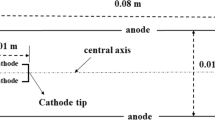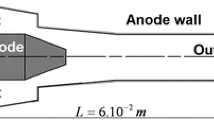Abstract
A 2D steady-state mathematical model of a GTAW electric arc was used to analyze the relative importance of the main heat transfer mechanisms that heat or cool the plasma in the arc column. The analysis consisted of building a map of the dominant mechanisms for heating and cooling the arc in each zone as well as their relative importance in terms of volumetric power. It was found that the primary inputs of energy are due to convection near the anode and Joule heating near the cathode, while the main cooling mechanisms have a complex structure that can be described in the map from cathode to anode, composed of Thomson effect, convection, radiation and conduction. A systematic analysis was conducted to evaluate the effect of the arc current, arc length, and plasma gas on the map of dominant mechanisms. The gases considered were Ar and He. The main effect of current is on the intensities and extent of the zones of dominance of the mechanisms. The arc length does not significantly affect the map, and the type of gas influences most of the dominant heat transfer mechanisms. The heat transfer near the anode is governed by the momentum and thermal boundary layers due to the plasma jet, while the cathode heat transfer is dominated by the heat transfer mechanisms associated with current flow. The information provided may be used to perform simple energy balances in specific zones of the arc to gain basic understanding of the physics in the arc.









Similar content being viewed by others
References
Ramakrishnan S, Stokes AD, Lowke JJ (1978) An approximate model for high-current free-burning arcs. J Phys D Appl Phys 11:2267–2280
McKelliget J, Szekely J (1986) Heat transfer and fluid flow in the welding arc. Metall Mater Trans A 17A:1139–1148
Goldak J, Bibby M, Moore J, House R, Patel B (1986) Computer modeling of heat flow in welds. Metall Trans B 17B:587–600
Dilawari AH, Szekely J, Westhoff R (1990) An assessment of the heat and fluid flow phenome inside plasma torches in non-transferred arc systems. ISIJ Int 30:381–389
Lowke JJ, Morrow R, Haidar J (1997) A simplified unified theory of arcs and their electrodes and their electrodes. J Phys D Appl Phys 30:2033–2042
Tanaka M, Terasaki H, Ushio M, Lowke JJ (2002) A unified numerical modelling of stationary tungsten-inert-gas welding process. Metall Mater Trans A 33A:2043–2052
Nestor OH (1962) Heat intensity and current density distributions at the anode of high current, inert gas arcs. J Appl Phys 33(5):1638–1648
Hsu KC, Etemadi K, Pfender E (1982) Study of the free-burning high-intensity argon arc. J Appl Phys 54:1293–1302
Eagar TW (1989) An iconoclast’s view of the physics of welding—rethinking old ideas. In: David SA, Vitek JM (eds) 2nd international conference on trends in welding research, Gatlinburg, Tennessee. ASM International, Materials Park, pp 341–346
Ramírez-Argáez MA, Trapaga G, McKelliget J (2004) A comparison between different numerical formulations for welding arc representations. J Mater Process Technol 155–156:1634–1640
Gleizes A, Gonzalez JJ, Freton P (2005) Thermal plasma modelling. J Phys D Appl Phys 38:153–183
Murphy AB, Tanaka M, Yamamoto K, Tashiro S (2009) Modelling of thermal plasmas for arc welding: the role of the shielding gas properties and of metal vapour. J Phys D Appl Phys 42(19):194006
Murphy AB (2015) A perspective on arc welding research: the importance of the arc, unresolved questions and future directions. Plasma Chem Plasma Process 35:471–489
Lowke JJ, Morrow R, Haidar J (1997) A simplified unified theory of arcs and their electrodes. J Phys D Appl Phys 30(14):2033–2042
Alireza JS, Choquet I (2016) A review of cathode-arc coupling modeling in GTAW. Weld Word 60:821–835
Baeva M (2017) Non-equilibrium modeling of tungsten-inert gas arcs. Plasma Chem Plasma Process 37:341–370
Murphy AB (2001) Thermal plasmas in gas mixtures. J Phys D Appl Phys 34(20):R151–R173
Terasaki H, Tanaka M, Ushio M (2002) Effects of metal vapor on electron temperature in helium gas tungsten arcs. Metall Mater Trans A Phys Metall Mater Sci 33(4):1183–1188
Chen FF, Xiang J, Thomas DG, Murphy AB (2019) Model-based parameter optimization for arc welding process simulation. Appl Math Model 81:386–400
Pichot F, Danis M, Lacoste E (2013) Numerical definition of an equivalent GTAW heat source. J Mater Process Technol 213(7):1241–1248
Pan JJ, Yang LJ, Hu SS (2017) Numerical analysis of keyhole formation and collapse in variable polarity plasma arc welding. Int J Heat Mass Transf 109:1218–1228
Ai Y, Jiang P, Shao X (2017) A three-dimensional numerical simulation model for weld characteristics analysis in fiber laser keyhole welding. Int J Heat Mass Transf 108:614–626
Nezamdost MR, Esfahani MRN, Hasemi SH (2016) Invesitgation of temperature and residual stresses field of submerged arc welding by finite element methods and experiments. Int J Adv Manuf Technol 87(1–4):615–624
García-García V, Camacho-Arriaga JC, Reyes-Calderón F (2016) A simplified elliptic paraboloid heat source model for autogeneous GTAW process. Int J Heat Mass Transf 100:536–549
Liu K, Yang F, Wang S, Gao B, Xu C (2018) The research on the heat source characteristics and the equivalent heat source of the arc in gaps. Int J Heat Mass Transf 124:177–189
Schnick M, Hertel M, Fuessel U, Uhrlandt D (2013) Energy balance in MIG arcs. J Phys D Appl Phys 46:224002
Ramírez MA, Trapaga G, McKelliget J (2003) A comparison between two different numerical formulations of welding arc simulation. Modell Simul Mater Sci Eng 11(4):675–695
Murphy AB, Arundell CJ (1994) Transport coefficients of argon, nitrogen, oxygen, argon–nitrogen and argon–oxygen plasmas. Plasma Chem Plasma Process 14:451–490
Murphy AB (1997) Transport coefficients of helium and argon–helium plasmas. IEEE Trans Plasma Sci 25:809–814
Cram LE (1985) Statistical evaluation of radiative power losses from thermal plasmas due to spectral lines. J Phys D Appl Phys 18:401–411
Cressault Y, Rouffet ME, Gleizes A, Meillot E (2010) Net emission of Ar–H2–He thermal plasmas at atmospheric pressure. J Phys D Appl Phys 43:335204
Delgado-Álvarez A, Mendez PF, Ramírez-Argáez MA (2019) Dimensionless representation of the column characteristics and weld pool interactions for a DC argon arc. Sci Technol Weld Join 24(7):634–643
Delgado-Álvarez A et al (2021) Generalized representation of arc shape, arc column characteristics and arc-weld pool interactions for DC electric arcs burning in monoatomic gases. J Phys D Appl Phys 54(5):055001
Acknowledgements
Funding for this project was provided by Conacy, Project PAPIIT IN 115617. Insightful conversations with David Apaoblaza and Stefano Sacco from the U. of Chile are gratefully acknowledged. José Alfredo Delgado Álvarez is a Ph. D. student in the ‘Programa de Doctorado en Ingeniería Química’, at the Universidad Nacional Autónoma de México (UNAM). He thanks CONACYT for receiving a doctoral fellowship (Grant Number CVU 446967).
Author information
Authors and Affiliations
Corresponding author
Additional information
Publisher's Note
Springer Nature remains neutral with regard to jurisdictional claims in published maps and institutional affiliations.
Rights and permissions
About this article
Cite this article
Velázquez-Sánchez, A., Delgado-Álvarez, A., Méndez, P.F. et al. Dominant Heat Transfer Mechanisms in the GTAW Plasma Arc Column. Plasma Chem Plasma Process 41, 1497–1515 (2021). https://doi.org/10.1007/s11090-021-10192-5
Received:
Accepted:
Published:
Issue Date:
DOI: https://doi.org/10.1007/s11090-021-10192-5




